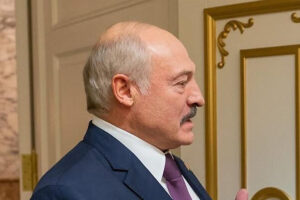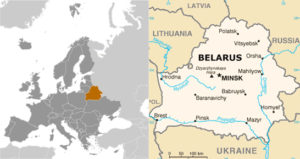As Lukashenka Turns To Geopolitics, The West Faces Learning Curve In Belarus

(Article text ©2020 RFE/RL, Inc., Radio Free Europe/Radio Liberty – rferl.org – Reid Standish – Aug. 24, 2020 – article text also appeared at rferl.org/a/as-lukashenka-turns-to-geopolitics-the-west-faces-learning-curve-in-belarus/30800512.html)
With hundreds of thousands of protesters flooding the streets of Minsk in recent days as Belarusian President Alyaksandr Lukashenka put the military on high-alert warning of a foreign-backed plan to oust him, the standoff in Belarus shows no signs of subsiding.
The embattled strongman has been back-footed by the massive, unprecedented demonstrations demanding he resign in the wake of the August 9 presidential election the protesters view as fixed.
And with nowhere else to turn to, he has gone looking to the Kremlin for support.
 Lukashenka — in power for more than a quarter-century — has in recent days even accused European Union countries of plotting a “color revolution” to topple him and warned that NATO is massing troops on Belarus’s western border.
Lukashenka — in power for more than a quarter-century — has in recent days even accused European Union countries of plotting a “color revolution” to topple him and warned that NATO is massing troops on Belarus’s western border.
The military alliance flatly rejects the charges in what appears an attempt by Lukashenka to elevate his full-blown domestic crisis into a geopolitical one reminiscent of standoffs between Russia and the West across the former Soviet Union.
Despite Lukashenka’s rhetoric, the events in Belarus remain domestically driven.
EU flags and ambitions of Western integration have not been a factor in the demonstrations that have spread across the country, with protesters and opposition figures such as exiled presidential candidate Svyatlana Tsikhanouskaya repeating that the protests are motivated by the desire to freely choose a leader and are not part of an anti-Russian or pro-Western movement.
But with poor relations and high suspicions between Moscow and the West, the EU and Russian responses to ongoing developments in Belarus are being shaped — for better or worse — by past experiences in Georgia, Ukraine, and Armenia.
“Everybody knows the Russian playbook after 2014 and is concerned about it, but the West and Russia are being far more careful now than before,” Paul Stronski, a former director for Russia and Central Asia on the U.S. National Security Council who is now a senior fellow at the Carnegie Endowment for International Peace, told RFE/RL. “The protests in Belarus are not geopolitical and the West isn’t looking to change that.”
Walking A Tightrope
European leaders have been quick to express solidarity with the protesters, but the EU has offered a calibrated response to the crisis that suggests the bloc’s leaders are wary of antagonizing the Kremlin to avoid military intervention by Russia on Lukashenka’s behalf.
While eager to defend democratic values, fair elections, and the rule of law, European leaders have hedged their response. EU foreign ministers have called the election results fraudulent, agreed on sanctions, and demanded the release of protesters unlawfully detained, but have not backed the opposition’s call for new elections.
Instead, the bloc has urged dialogue between the government and the opposition to foster a “peaceful transition of power.”
“The tone from the EU suggests a clear acknowledgement of a Russian role in the outcome and that there is still some hope that it’s possible to engage with Russia constructively,” Joerg Forbrig, the director for Central and Eastern Europe at the German Marshall Fund in Berlin, told RFE/RL.
Crisis In Belarus
[From RFE/RL’s original post:] Read our coverage as Belarusians take to the streets to demand the resignation of President Alyaksandr Lukashenka and call for new elections after official results from the August 9 presidential poll gave Lukashenka a landslide victory.
Finding a constructive solution with Russia on the stalemate in Belarus would involve the EU overcoming the lack of trust that cratered relations with Moscow following its 2014 annexation of Crimea and the ensuing war in eastern Ukraine.
But the events in Belarus vary markedly from those in neighboring Ukraine in 2014, which were a direct response to Ukrainian President Viktor Yanukovych’s decision to abandon European integration and reforms in favor of the Moscow-led Eurasian Union. This led to the EU and Ukraine’s future political orientation becoming a central factor of the protest movement that led to Yanukovych’s departure and Russia’s intervention.
In Belarus, the situation remains different, with the focus on the erosion of rights and opportunities during Lukashenka’s 26-year reign as president.
This has led some commentators, such as former Swedish Prime Minister Carl Bildt, to argue that the 2018 revolution in Armenia — where mass demonstrations led to the resignation of longtime President Serzh Sarkisian — is a more instructive example for Belarus.
In an August 18 op-ed, Bildt said Armenia offered the best template for current developments in Belarus, where fresh elections could pave the way for a new government. While Armenian protests pushed out Sarkisian, the new administration led by Prime Minister Nikol Pashinian has retained the country’s pro-Russian policies.
“To ensure a smooth process, Belarus’s external orientation should be kept off the table,” Bildt wrote. “The election and broader struggle must be solely about democracy within the country, and nothing else.”
“Russia doesn’t always intervene if a previous partner loses an election. They can live with power transfers and Armenia is the best recent example of that,” said Forbrig. “Russia is still shaping its approach in Belarus and has shown in the past it can be adaptable.”
Looking For A Toolbox
But unlike Sarkisian in Armenia, Lukashenka shows no signs of leaving office on his own accord and shouted at protesters during a visit to a factory that “there will be no new election until you kill me.”
Despite the nationwide protests against his rule, Lukashenka still appears to enjoy overwhelming support among the military and security services and, unlike in Armenia, the Belarusian authorities had no qualms about using force against their citizens, violently breaking up demonstrations, detaining people in mass, and reportedly torturing protesters.
With Lukashenka making it clear he intends to hang on to power and no clear path towards a political transition on the horizon, the EU has few other policy options than the sanctions and support that it has already offered.
Maryia Sadouskaya-Komlach, a Belarusian journalist and program coordinator at Free Press Unlimited, told RFE/RL that she believes the EU was not making enough use of the preexisting mechanism it already possesses, in particular the European Endowment for Democracy (EED), an organization founded by the bloc to support civil society and political activists. The EED has been notably quiet during the weeks of protest in Belarus, which Sadouskaya-Komlach thinks sends a signal of indifference to the protesters.
Meanwhile, sanctions appear to be the main option in the EU’s toolbox, but with Belarus being sanctioned in some form or another by Europe since 1997 and not having changed course by now, the utility of the sanctions seems limited. “The EU wants to use targeted sanctions as a symbol of its tough actions against Lukashenka, but it is instead a symbol of its policy failure,” Sadouskaya-Komlach said.
A Confused Kremlin
The current situation is also a policy conundrum for the Kremlin.
Regardless of how the current situation ends, Moscow will retain significant influence in Belarus.
The economy relies heavily on Russia, which effectively subsidizes Minsk with low-cost oil and gas shipments and the two countries are well-integrated — a union that the Kremlin is keen to deepen.
Furthermore, Russian President Vladimir Putin and Lukashenka have a famously tense relationship, with the Belarusian president eroding his own standing with the Kremlin by resisting Putin’s push for deeper economic union.
But Lukashenka’s dominance of Belarusian politics creates a quandary for Russia.
Unlike in Ukraine, where the Kremlin has spent decades cultivating pro-Russian politicians, parties, and oligarchs, Belarus has few alternatives for Moscow to support. Similarly, Tsikhanouskaya, who is in exile in Lithuania, and her campaign, which allowed members of Belarus’s traditional Western-funded opposition to dominate the postelection Coordination Council, are viewed with suspicion by Moscow.
“This can’t be a situation like Armenia because Lukashenka won’t give up,” Angela Stent, a former U.S. national intelligence officer on Russia and a professor at Georgetown University, told RFE/RL. “I can’t see him giving up peacefully, let alone negotiating him leaving the country or holding new elections.”
For the time being, Moscow appears to be backing its problematic partner in Minsk as he tries to cling to power.
Russian Foreign Minister Sergei Lavrov recently warned that the situation in Belarus was a “continuation” of the tug-of-war between Russia and the EU over Ukraine in 2014 and claimed that the thus far very peacefully protesting opposition wants “bloodshed.”
“No one wants a repeat of Ukraine in 2014 and no one wants to do anything that will provoke Russia,” Stent said. “There is a very limited toolbox for the West here.”
